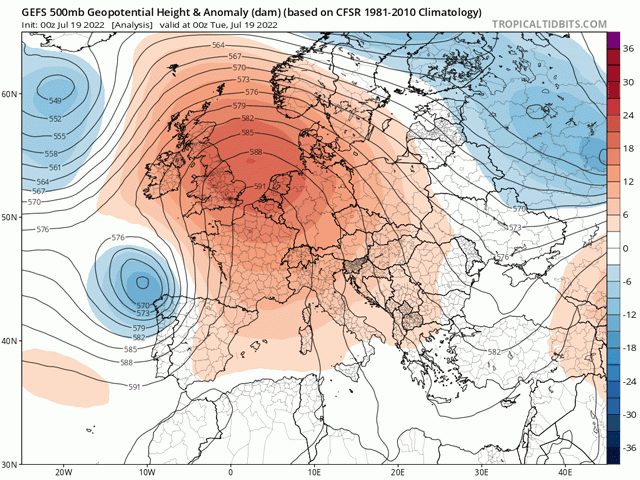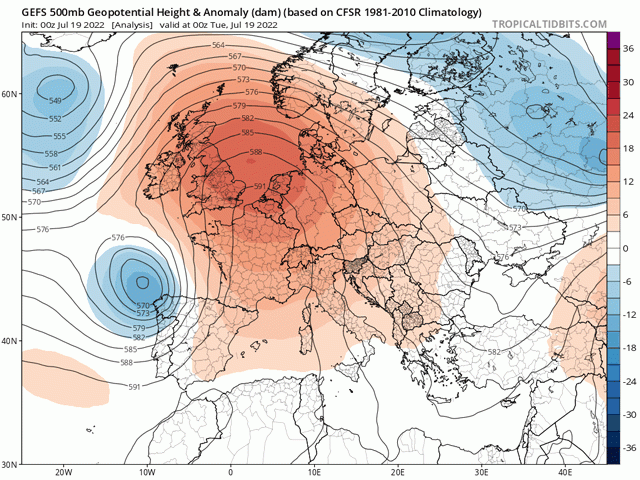Ag Weather Forum
Europe Record-Breaking Heatwave Continues to Spread
Very hot weather has been prone to appear in the Central and Southern Plains in the United States so far this year. Like most years, several days have hit triple digits Fahrenheit. That is not as common though for a lot of Europe. A heatwave this week is pushing those boundaries and setting records.
On Monday, temperatures eclipsed the 100-degree Fahrenheit (37.8-degree Celsius) mark in Portugal, Spain, Italy and France. At 47 C (116.6 F), Pinhao, Portugal set its all-time high temperature record.
As of mid-afternoon on Tuesday, areas that eclipsed the 100-degree mark spread into the United Kingdom, Netherlands, Belgium and western Germany. By reaching 40.2 C (104.4 F) at Heathrow Airport in London, the UK set its all-time high temperature for the country, eclipsing 40 C for the first time in recorded history. Its previous record was 38.7 C (101.7 F) in 2019.
It is actually very difficult to get temperatures to exceed 100 F in the UK since the country is so far north and surrounded by water. At 51.5 degrees north latitude, London is farther north than Calgary, Alberta, Canada.
The current heatwave is due to an intense upper-level ridge in western Europe that is pulling hot air out of northern Africa. But this extreme portion of the ridge is rather acute, encompassing only western Europe.
P[L1] D[0x0] M[300x250] OOP[F] ADUNIT[] T[]
At the same time as records were being broken on Tuesday, a cold front moving off the Atlantic was pushing inland, bringing temperatures back down into the 20s C (70s and middle 80s F). That should provide a break in the heat as the front sweeps across the far northern areas of the continent this week. But ahead of that system, the heat will continue to push eastward.
For Wednesday, the heat will center on Germany into western Poland, then shift into Poland and the Balkans states for Thursday and Friday. Northern areas of the continent will see that front moving through behind the heat, but the southern stretches of the continent south of the Alps in Italy and southeastern Europe will continue to see the heat, and a new wave is forecast to spread across the western countries Sunday into early next week.
The secondary burst is not likely to be as extreme as the first, but could still push near-triple-digit heat back into France and southern Germany for a couple of days. Models are also pointing to more heat continuing for the rest of July and into August.
The heat comes when dryness and drought have been overspreading western Europe since the spring. The region got some relief in June, particularly in France, but soil moisture is certainly lacking.
With all the heat and dryness, wildfires have been the result. According to a map published by Metro News on July 18 here: https://metro.co.uk/…, wildfires are being seen in almost every country in Europe. Some of the more devastating ones have been occurring in Portugal, Spain, and southwestern France where thousands of people have been evacuated. Hundreds of deaths are already blamed on the heat that started to roll in last week, but have certainly intensified during the last few days.
In the agricultural realm, the heat is coming during winter wheat and winter grains harvest. And although wildfires could cause damage for those yet to harvest, the heat will not affect yields in a significant way for that crop. However, spring grains like barley and oats and summer crops like corn, soybeans, and sunflowers will continue to undergo significant stresses for the next several weeks.
That is hastening crop development as much of the crop is in reproductive or early fill stages. Satellite-derived estimates of crop health show large areas of Europe under stress. The only areas not currently experiencing significant crop stresses are around Belarus north into Scandinavia and around Greece.
Livestock and poultry producers are certainly feeling the stress as well with pastures and water holes drying up. The heat is also likely to cause at least some deaths.
To find updated weather analysis from DTN, head over to https://www.dtnpf.com/…
John Baranick can be reached at john.baranick@dtn.com
(c) Copyright 2022 DTN, LLC. All rights reserved.





Comments
To comment, please Log In or Join our Community .